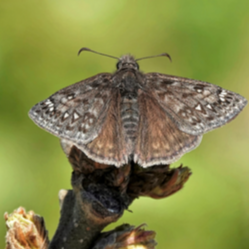Updates from the Field: Lotus Pinnatus Covenant at Harewood Plains
By Lauren McIndoe, Lead Restoration and Spatial Data Technician
This past month, the field crew headed up island to Nanaimo to help support restoration efforts in a unique protected area known as the Lotus Pinnatus covenant, nestled within the larger Harewood Plains. A heartfelt shout-out to Michael (HAT’s recently retired accountant) and his partner Jean for hosting the crew with a much-loved BBQ and backyard campout while we were working up island!
During the BBQ campout at Michael and Jean’s place, Michael, Vanessa, Dana, and Lauren observed a Merlin (Falco columbarius) in the tree through binoculars.
Photo by Chelsea Nuez.
Harewood Plains
Harewood Plains is a Garry oak-associated ecosystem that supports several rare and threatened species including:
Red-listed Species (Extirpated, Endangered, or Threatened)
Bog bird’s-foot lotus (Hosackia pinnatus) (formerly known as Bog bird's-foot trefoil (Lotus pinnatus)
Dense spike-primrose (Epilobium densiflorum)
Herman’s dwarf rush (Juncus hemiendytus)
Muhlenberg’s centaury (Zeltnera muehlenbergii)
Howell’s violet (Viola howellii)
And provides habitat to the Propertius duskywing (Erynnis propertius) butterfly
Blue-listed species (Special Concern)
Slimleaf onion (Allium amplectens)
Long-bristled frillwort (Fossombronia longiseta)
Purple crystalwort (Riccia beyrichiana)
Northern red-legged frog (Rana aurora), which is threatened by wetland habitat loss
Vernal Pools
Harewood Plains is characterized by conglomerate bedrock with thin organic soils that create spring seeps and vernal pools. Vernal pools are temporary bodies of water that fill during the rainy winter season and dry out in summer, creating unique habitat conditions. Because they dry up in summer, vernal pools don’t support fish, making them safe havens—mostly free of predation—for amphibians like frogs and salamanders, and invertebrates like fairy shrimp and dragonfly nymphs. Additionally, the plants that thrive in vernal pools have adapted to survive the dynamic, seasonally wet and dry conditions. Vernal pools are pretty cool and unique little biodiversity hotspots!
A dried vernal pool at Lotus Pinnatus during the summer season (July 4th 2025). Photo by Lauren McIndoe.
Vernal pools specific to Garry oak ecosystems are habitat to a variety of rare or endangered plant species, including:
Bog bird’s-foot lotus (Hosackia pinnatus)
Tall woolly-heads (Psilocarphus elatior)
Kellogg's rush (Juncus kelloggii)
Water plantain buttercup (Ranunculus alismifolius var. alismifolius)
Rosy owl-clover (Orthocarpus bracteosus)
Dwarf sandwort (Minuartia pusilla)
Nuttall's quillwort (Isoetes nuttallii)
Protecting the Plains
Despite its rich biodiversity, Harewood Plains faces ongoing threats. ATV use damages fragile soils and hydrology, while nearby housing developments and BC Hydro activities continue to place pressure on the ecosystem. The Lotus Pinnatus covenant and its surrounding habitats require ongoing care and advocacy.
You can help by spreading awareness of this sensitive habitat and supporting the many stewards working to protect it. Together, we can help ensure these unique ecosystems and the many species that rely on them continue to thrive.
To learn more about the protection of species at risk in vernal pools associated with Garry Oak Ecosystems, check out the Recovery Strategy for Multi-Species at Risk in Vernal Pools and other Ephemeral Wet Areas Associated with Garry Oak Ecosystems in Canada (Proposed)-2005. For more information on the protection of Harewood Plains and the Lotus Pinnatus covenant, visit https://nalt.bc.ca/harewood-plains/.







